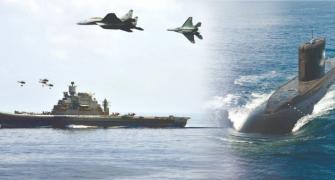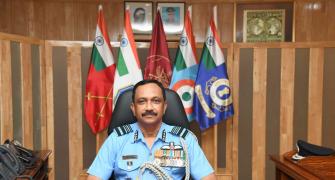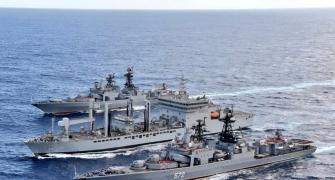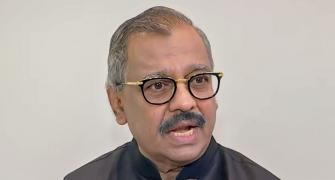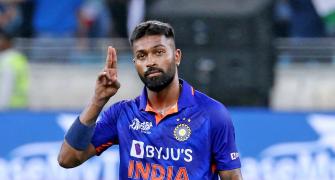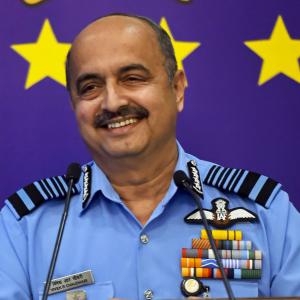As India progresses towards formulating its own model of theaterisation, the public must get involved in the debate because in the end, it affects the well-being of the entire nation, asserts Vice Admiral Biswajit Dasgupta (retd).

Theaterisation of the Indian armed forces has been in and out of public attention for the past three years or so.
Discussions on the subject have been restricted to 'informed' circles and there is at most, a foggy understanding of the concepts and ideas that surround the entire issue of theaterisation.
That is unfortunate for two very good reasons. First, the armed forces belong to the entire nation. They exist to preserve and protect the sovereignty and integrity of India. They are meant to prevent conflict through a show of strength (deterrence); and fight and win convincingly if dragged into war.
The public is the body that suffers the consequences of conflict and therefore they must be assured of the effectiveness of their armed forces in conflict.
Second, the employment of the armed forces is an involved exercise in civil-military relations.
Armed forces officers are domain specialists, but lack a complete understanding of other crucial aspects of National Grand Strategy.
Employment of the armed forces is undoubtedly a vital component of this Grand Strategy.
There needs to be wider public understanding about the armed forces and their role in national security including evolutionary processes such as theaterisation.
Trinity of Combat
The Army, the Navy and the Air Force are the three main components of the armed forces that are expected to fight land, maritime and air battles respectively.
At the time of Independence, India inherited a modest Army, Navy and Air Force, which, over the past three-quarters of a century have grown into formidable fighting organisations.
From being ill-equipped and inexperienced armed forces in 1962, the country went on to fight two more major wars in 1965 and 1971 and conduct several other major operations where our prowess, professionalism and patriotism were unquestionably of the highest order.
However, we fought singly in the most part, with land, maritime and air campaigns being planned and executed separately with a loose coordination between cooperating forces.
There have been instances of air-land cooperation, but at a rudimentary level.
This is because we were neither equipped adequately to fight complex battles nor conceptually mature for joint employment of forces.
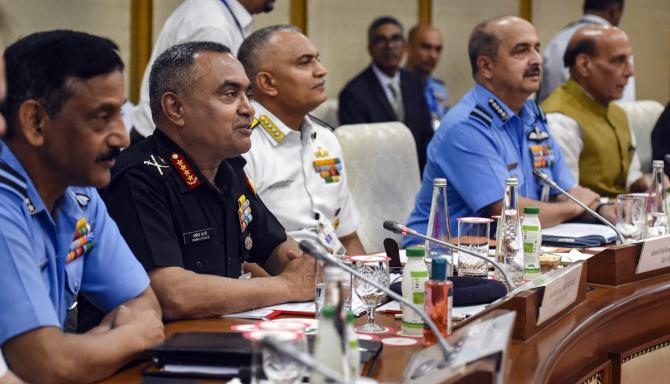
Jointness
As conflicts erupted the world over, it came to be accepted that no single service can prosecute complex operations on its own and that 'jointness' was indeed the way forward.
Jointness meant officers and other ranks of each service needed to know and appreciate what the other two did, and how planning and execution of warfare could be achieved jointly.
This required joint employment of forces and sometimes subordinating one service's role to the other for the overall achievement of war aims.
The ground forces -- the Army on land and the Navy at sea would always be the final arbiter of conflict.
While the Air Force can and must prosecute certain air campaigns on its own, it needs to robustly support the ground forces.
This thinking was new and since the services operated in silos inside their own kingdoms, turf wars emerged.
None of the services took kindly to sharing of assets or subordination of role to another service.
There was also serious discomfort in joint planning and sharing of information with sister services.
The enunciation of joint doctrines has been of recent origin in India, as late as the late 1990s and early 2000s.
Experiments in jointness meant a healthy 'give and take' and while everyone was happy with the 'take', nobody wanted to 'give'.
The Navy, the smallest service, was the first to give jointness a chance when it agreed to experiment with Andaman and Nicobar Islands.
The envisaged Far Eastern Naval Command gave way to the joint Andaman and Nicobar Command (ANC) in 2001 with naval assets becoming common and positions held by naval officers, including the Commander-in-Chief, becoming rotational.
The other two services did not display the same enthusiasm and a review of effectiveness of the Command that was to take place ten years after its inception never took place.
Needless to mention, the balance of exchange did not favour the Navy.
Many in the armed forces consider the ANC to be a failed experiment, but are not willing to admit it openly.
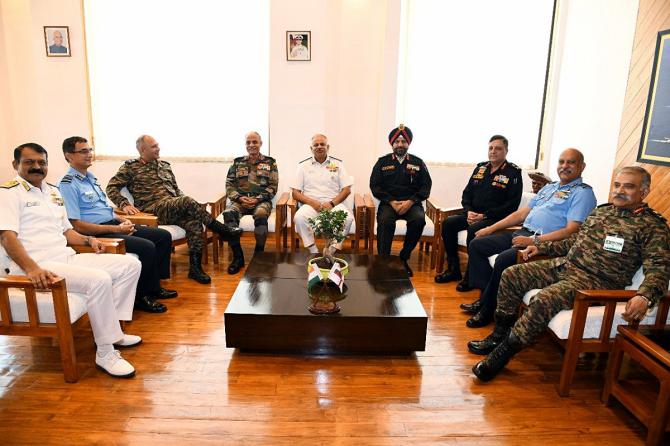
Integration
'Jointness' and 'Integration' are terms that are sometimes used interchangeably. The difference between the two needs explanation.
Jointness alludes to 'fighting together' or joint employment of forces in combat.
It has been established that the effect of joint employment of forces far exceeds the sum of its parts and creates the desired 'effect'.
Those who speak about 'effect-based operations' are saying just this in military jargon.
Integration is quite another concept and refers to the enablers that bring about seamless joint employment of forces.
The three services have diverse equipment and combat platforms.
They just cannot be fielded together and become effective as a joint force.
There is a range of enablers that are critical in 'integrating' the forces so that they can become cohesive, combat-worthy and credible fighting formations.
These include common communication and networking protocols, compatibility of equipment, streamlined joint planning mechanisms, well-understood joint doctrines, clear Standard Operating Procedures (SOP), well-defined responsibilities and competent joint workforces in headquarters and formations.
Joint training is also a critical enabler and will impact integration.
There are other aspects of military operations such as intelligence, surveillance, reconnaissance, space, cyber, and special operations, the integrated employment of which would be critical in any future conflict.
In a single sentence, if jointness implies the joint employment of forces in combat, integration implies how this will be made to happen.

Theatres
In this backdrop, how do we see 'theaterisation'?
A theatre, as the name implies, has geographical connotations. A battle is fought in a geographical area.
Small geographical areas are called tactical battle areas and a larger area can be called a theatre of operations.
Hence, we commonly hear terms such as Northern Theatre, Eastern Theatre, Western Theatre or Maritime Theatre.
Theatre forces conduct military campaigns within their respective theatres, with inter-theatre coordination, as necessary.
Theatres should have theatre commanders, who bear full responsibility for planning, execution and outcomes of the campaigns entrusted to them.
Directives to these theatre commanders flow from a Joint Headquarters under the Chief of Defence Staff (CDS), suitably empowered with operational powers and forces allocated for specific campaigns by the respective service upon orders of the CDS.
This is how theatre commands function in general.
Are Theatres Integrated or Joint?
Armed with this knowledge, should theatre commands be called 'integrated' or 'joint'? Does it matter? A theatre command should be able to employ 'joint' forces effectively in combat and its allocated forces must be seamlessly 'integrated' to be able to do so. Everything else is a play of words.
There is a working system in place. If it must be revamped, there must be assurance of 'integration' aspects first, lest we find ourselves disjointed-in-theatre.
As India progresses towards formulating its own model of theaterisation, the public must get involved in the debate because in the end, it affects the well-being of the entire nation.
Vice Admiral Biswajit Dasgupta (retd) is a former Commander-in-Chief of the Eastern Naval Command.
Feature Presentation: Aslam Hunani/Rediff.com

